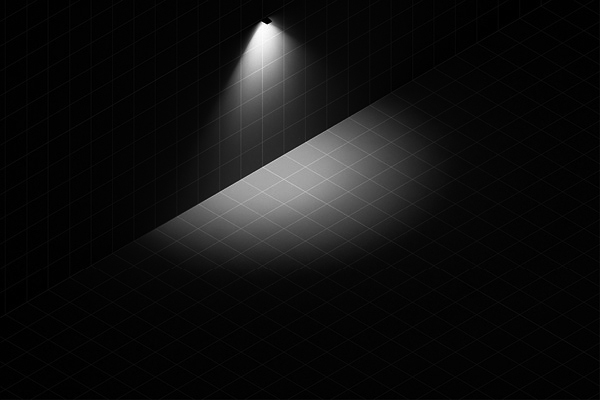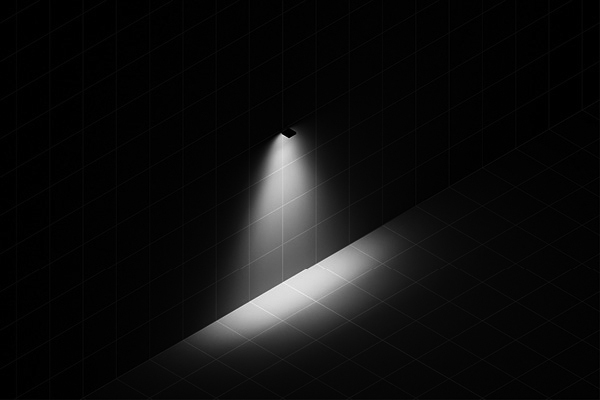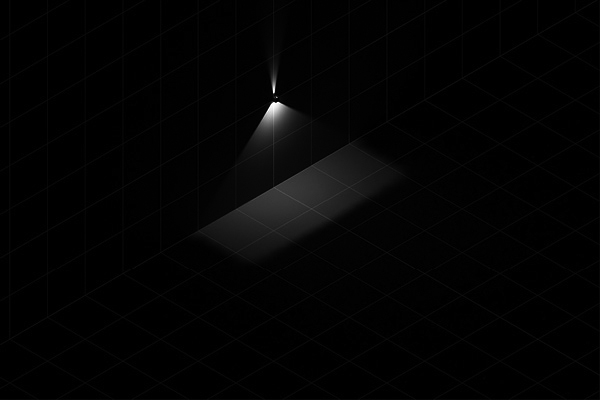The Group's luminaires offer different types of optics depending on project requirements. The optic can be identified as the set of equipment designed to direct the light generated by a light source in a particular direction, thus determining the luminous emission of the luminaire itself.
The diagram below identifies the data that will be contained in subsequent pages, regarding the opening angle of the beam.
IMAX = maximum luminous intensity, i.e. the maximum intensity of the emitted light beam.


Depending on this luminous emission, PERFORMANCE iN LIGHTING classifies optics in the following categories:

For PERFORMANCE iN LIGHTING, symmetric optics are ones with symmetric emission in relation to planes α and β.
The symmetry between the two planes may be either identical (in this case we are dealing with optics with square light distribution) or different (optics with rectangular light distribution).
EXAMPLE
Symmetric optic code: S/xx
where:
S = Symmetric
xx = the abbreviated name of the opening angle
For example: S/I - S/M - S/W - S/EW
By convention, we consider the beam opening of plane α. Multiple optics within the same range of opening will be distinguished by inserting the numerical value of the beam opening at the end.
For example: S/W50 - S/W60
| Symmetric optic name | ||
| Type of optic | Acronyms | Opening angle plane α |
S |
I | 0° ÷ 20° |
| M | 21° ÷ 45° | |
| W | 46° ÷ 75° | |
| EW | > 75° | |
| Mandatory indications | Additional indications |
| Type of opening | Description |
| S1 S2 |
Includes all symmetrical optics from Narrow to Wide for Power LED |
| SN SM SW |
Includes all symmetrical optics from Narrow to Wide for COB |
| ARRAY | Free distribution |
| MEDIUM | Medium beam diffuser |
| OPAL MICRO |
Wide beam diffusers |
| SYMM | Symmetrical optic |

With this classification PERFORMANCE iN LIGHTING identifies the light emission typology of the luminaires inside those series that contain models with direct, indirect and / or combined light emission.
| Name of symmetrical optics for luminaires with double light emission | |||
| Type of optic | Acronyms | Typology of light emission | |
S |
S/A | Direct symmetrical light |  |
| S/B | Mainly symmetrical direct light |  |
|
| S/C | Evenly direct - indirect symmetrical light |  |
|
| S/D | Mainly symmetrical indirect light |  |
|
| S/E | Indirect symmetrical light |  |
|

PERFORMANCE iN LIGHTING asymmetric optics generally have asymmetric light distribution on plane α with a point of maximum concentration.
The axis passing through the point of maximum concentration and the point marked by the axis of the lamp is called the Imax axis.
The light distribution on plane β, on the other hand, may be symmetric or asymmetric.
An asymmetric optic may be symmetric in relation to one plane only.
EXAMPLE
Asymmetric optic code: Ayy/xx
where
A = Asymmetric
yy = numeric value of the Imax angle.
The Imax angle is the angle between axis A and the lmax axis.
xx = the abbreviated name of the opening angle
For example: Ayy/I – Ayy/M – Ayy/W – Ayy/EW.
By convention, the beam opening of plane α is considered.
For example:
A30/M = Asymmetric axis with Imax 30° and Medium opening
A45/I = Asymmetric axis with Imax 45° and Intensive opening
In the presence of multiple asymmetric optics with the same lmax value and same beam opening range, it will be necessary to distinguish them by adding the numeric value of the beam opening at the end.
For example: A45/M25 - A45/M40
| Asymmetric optic name | |||
| Type of optic | Imax angle | Acronyms | Opening angle plane α |
A |
Numeric value of the Imax angle |
I | 0° ÷ 20° |
| M | 21° ÷ 45° | ||
| W | 46° ÷ 75° | ||
| EW | > 75° | ||
| Mandatory indications | Additional indications |
| Type of opening | Description |
| A1 A2 A3 |
Includes all asymmetrical optics from Narrow to Wide for Power LED |
| ASW ALW |
Includes all asymmetrical optics from Narrow to Wide for COB |
| ASYMM | Asymmetrical optic |

PERFORMANCE iN LIGHTING identifies those optics that generate a luminous emission with a symmetry of revolution about the A axis as circular optics.
The opening angle of the beam is generally constant in all planes.
The reflectors generating these optics generally have a circular opening.
EXAMPLE
Circular optic code: C/xx
where:
C = Circular
xx = the abbreviated name of the opening angle
For example: C/I - C/M - C/IW - C/MW -C/EW
Multiple optics within the same range of opening will be distinguished by inserting the numerical value of the beam opening at the end.
For example: C/IW46 - C/IW50
| Circular optic name | ||
| Type of optic | Acronyms | Opening angle plane α |
C |
I | 0° ÷ 20° |
| M | 21° ÷ 45° | |
| IW | 46° ÷ 60° | |
| MW | 61° ÷ 75° | |
| EW | > 75° | |
| Mandatory indications | Additional indications |
| Type of opening | Opening angle α |
| C1 | 30° ÷ 45° |
| C2 | 25° ÷ 30° |
| C3 | 20° ÷ 25° |
| C4 | 15° ÷ 20° |
| C5 | 10° ÷ 15° |
| C6 | 0° ÷ 10° |

PERFORMANCE iN LIGHTING elliptical optics are circular but differ from roto-symmetrical circular optics because the opening of the light beam on planes α and β is symmetric, but differs greatly between the two. The light distribution is highly elliptical.
EXAMPLE
Elliptical optic code: E α x β
where:
E = Elliptical
α = Opening of the light beam on plane α expressed in degrees
β = Opening of the light beam on plane β expressed in degrees
For example: E 10°x45°

Grazing reflector optics stand out for their luminous emission that is typically parallel (grazing) to the installation surface (wall or ground).
These optics are primarily used for architectural lighting with the purpose of designing patterns of light and they rarely have a functional use.
A fundamental characteristic is the value of the α angle that identifies the value of the light beam aperture measured on the installation surface.

Installation surface (wall)

Installation surface (ground)

For road optics, PERFORMANCE iN LIGHTING identifies the optics that have a very broad beam spread on the β plane (usually greater than 120°), with the point of maximum emission on one of the adjacent planes to the latter, up to a maximum of 45°.
Road lighting based on L/H ratio that can be found in road lighting systems, where:
EXAMPLE
Acronym of the road optics based on the L/H ratio: R/xxx
where:
R = road
xxx = L/H value (e.g. 100 = 1.00)
For example: R/075, R/100
| Name of the road optics based on the L/H ratio: | |||
| Type of optic | Acronyms | Description | |
 |
SR |
075 | Optic for L/H fino up to 0,75 (0,5 ≤ L/H ≤ 0,875) |
| 100 | Optic for L/H pari of 1 (0,875 ≤ L/H ≤ 1,125) | ||
| 125 | Optic for L/H pari of 1,25 (1,125 ≤ L/H ≤ 1,375) | ||
| 150 | Optic for L/H pari of 1,5 (1,375 ≤ L/H ≤ 1,625) | ||
| Mandatory indications | Additional indications |
| Acronyms | Description |
| HUGE | Optics for wide road geometries |
| WIDE | Optics for medium road geometries |
| ST1 | Optics for medium-wide road geometries |
| CYCLE | Optics for pedestrian crossings |

For optics for pedestrian crossings PERFORMANCE iN LIGHTING identifies those optics for lighting in the direction of their flow.
They feature asymmetrical emission both on the α plane and on the β plane.
EXAMPLE
Acronym of optics for pedestrian crossings: Z/R
where:
Z = zebra (pedestrian crossing)
R = right (for countries where driving is on the right)

Two-way traffic

One-way traffic